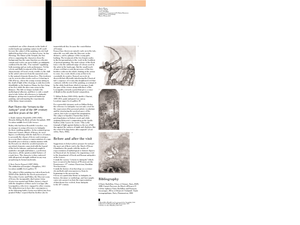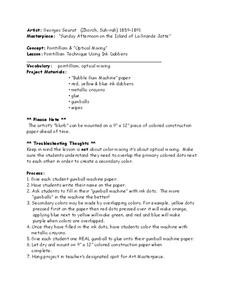Bright Hub Education
Math Lesson for Visually Impaired Early Learners: A 3 Way Counting Activity
A unique lesson plan that's designed for visually impaired early learners, but can be adapted for anyone, is here for you. Pupils use brightly colored foam letters, beads, checkers, and an abacus, in order to gain practice in identifying...
Curated OER
An Introduction to the Relationship Between Composition and Content in the Visual Arts
Students investigate how artists create a story that provides a message or provokes emotions in a single image. The ways in which the composition of a painting contributes to telling the story or conveying the message is examined in this...
Curated OER
Repeat After Me: Repetition in the Visual Arts
Students explore one of the techniques artists often use to highlight important elements within a painting's composition and to move a viewer's eye around the canvass from highpoint to highpoint.
San Francisco Symphony
Instrument and Visual Appreciation of Art
There are a lot of great ideas to be found here. To better understand the connection between art and history, learners research several music and art pieces, then relate them to major social events. They study the lives and works...
Curated OER
Visual Arts - Mexican Indian Yarn Painting
Have you ever seen a Mexican yarn painting? They're beautiful! Create a Mexican yarn painting with your class using this lesson plan. Start by discussing Mexico's culture and viewing different yarn paintings. After reading about...
J. Paul Getty Trust
Looking and Learning in the Art Museum — Lesson 1
To prepare for a field trip to a local art museum, art class members journal their initial reactions to a reproduction of the work they will focus on during their visit. The whole class then considers the artistic elements in the piece...
J. Paul Getty Trust
Looking and Learning in the Art Museum — Lesson 2
Is there a difference between examining an original work of art and viewing a reproduction? Class members are asked to reflect on this question after researching a piece, study a reproduction of it, and the examining the original in an...
Chymist
Visualizing pH
Why are acids and bases important in our daily lives? Lead the class in answering this question, among others, as they experiment with pH paper and classify where various substances belong on the pH scale. They also taste common acids...
Curated OER
References to Antiquity in Visual Arts (1848 - 1914)
Examine the Latin and Greek language and civilization during the 19th century by exploring the mediums available then. Learners examine scenes related to Greek and Roman literature and compare and contrast them.
Perkins School for the Blind
Learning Names of Articles of Clothing
What to wear today; such a vexing question. Spend some time introducing the names, fabrics, types, colors, and functions of various articles of clothing to your class. Each child will take turns asking each other what they are wearing....
Brigham Young University
Introducing the Text and Learning the Process of Script Analysis
Where do directors and set designers get their ideas so that the set they build creates the mood and atmosphere the director wants for a production? From the script! Introduce theater high schoolers to the script analysis techniques used...
Curated OER
Visual and Meaning Cues
Learn how to apply visual and meaning cues to reading unknown words. Readers will explore what to do when they come to a word they do not know as they watch the teacher model the use of these cues and then participate in guided and...
Mind Snacks
Learn Chinese (Mandarin) - MindSnacks
Acquire over 1000 Chinese words while playing games! Mandarin Chinese, one of the most desired languages in business and technology, is the focus of this teaching tool. Users will pick up vocabulary and practice tones, all while tapping...
North Birmingham Academy
Color Theory
What better way to learn about colors than by coloring? Starting with the primary colors, young artists follow written prompts to shade in various rectangles and a color wheel to show complementary colors, tints and shades, and more.
US Department of Commerce
Learning About College Degrees and Lifetime Earnings
It's never too early to start thinking about college majors. Using census data, scholars research the lifetime earnings for two selected careers. They then write and solve word problems to compare the amounts. To add a visual component,...
Thoughtful Learning
Checking the Emotion Thermometer
A hand-drawn thermometer provides a strong visual for how much of an emotion a child is feeling. Scholars color the thermometer's mercury to showcase whether what they are feeling is high or low at a certain moment. Questions allow...
J. Paul Getty Trust
Looking and Learning in the Art Museum — Lesson 3
Curator, artist, art handler, archivist, conservator-restorer, guide. Who would have thought there were so many different kinds of museum professionals? After a visit to an art museum, class members reflect on the role of the museum in...
Curated OER
Pointillism Technique Using Ink Dabbers
A gumball machine art project is a great way to learn about optical mixing in a study of pointillism and Georges Seurat. Kids create their own masterpieces and learn about primary and secondary colors in the process.
Marine Institute
Bubble Art – Learning About Paint and Color
To gain an understanding of color mixing theory and the color wheel, young artists draw a picture, mix up a batch of secondary colors to which they add dish soap, and using straws, bubble up the paint. They then press their drawings onto...
Missouri Department of Elementary
Communicating with I-Messages (2/2)
Class members read a handout to learn about using I-Messages—honest statements that begin with I to get their points of view across. Next, learners practice using I-Messages with partners to better communicate without hurting others'...
Keynotes Education
The Recorder - B
Make some beautiful music with a lesson about playing the recorder! After learning some of the basic fingering positions and notes, have kids practice their skills with two easy songs.
Curated OER
How Are Colors Created?
Kids explore primary and secondary colors, as well as the concepts of tints and shade in a series of color lessons. The packet includes detailed directions for how to use BrainPOP Jr. resources to create learning stations where kids...
Smithsonian Institution
George Washington: A National Treasure
Uncover the answer to a specific clue in a portrait of George Washington with a spyglass in an Internet-based interactive. Learners read a clue to an item hidden in a portrait of the First President of the United States in the last years...
Curated OER
Arc GIS Project: Visualizing the Holocaust
A cross-curricular lesson plan for middle schoolers that covers language arts, social studies, geography, and math, this is a great extension activity if your class is reading The Diary of Anne Frank or learning about the Holocaust....

























